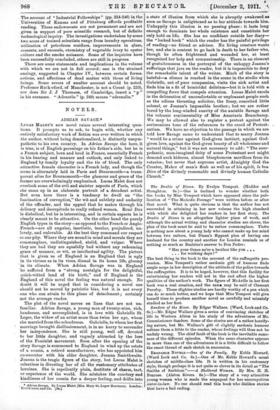'CIIESITCLL THE author ofthis book, although ,greatly interestetlin the- latest
-developments of chemical and ptiyaicaltheory, is very farfrom being-one-Of those scientists who despise the applications of pure discovery. Indeed, two-thirds of the volume` bdore -us are devoted to the discussion of industrial problems. .We pass from the study of electrons, of atom-counting, of "the decaying sequences of the radio- active elements " on to such thoroughly practical matters- as --the utilization of stale bread, the 'improvement of dental cements, and the direct welding of copper .to iron. Nearly two:thirds of the 'book are conspicuously practical, touching many 'human interests in connexion with -the household, the farm, the-forest, the mine, and what not. Just one concrete example may be cited, that Of the pmduc- tion,-natural and artificial, of the aromatic compound, camphor. This -may be made synthetically, starting from turpentine, but not cheaply enough to oust the natural product from commerce, although the manufacture may serve totkeep_pricee within moderate limits. Thus the practical monopdly of the trade in Formosan camphor possessed'by 3a,pan is threatened hy this-purely scientific discovery. Moreover, analysis Shows that the leaves of 'the camphor 'tree contain more camphor -than-the wood, so-that the-felling of the trees when they have reached a certain age is proved to be a wasteful operation. Even the fallen-leaves contain a higher percentage of camphor than the wood. Another consideration comes in 'to cheapen the natural product; -the camphor tree can 'be grown success- fully elsewhere-than-in. Formosa. -Professor talc) Giglioli in his monograph, La Canfora Italiana, shows this in relation to Italy, and-the same success has followed similar -experiments in Jamaica, Malaya, Ceylon, and some parts of the 'United. States. It maybe mentioned here that-the case of synthetic -versus natural camphor resembles that of synthetic versus -natural rubber.
Although Chapters IX., X., and XI. deal with the relations between chemistry and manufactures in the United 'States, they comprise -matters of world-wide interest and importance.
• Some Chemical Problems of -To-day. By Robert Kennedy -Duncan. Illy, trated. London: Harper Brothers. Vs. 6d. net.]
The account of "Industrial Fellowships" (pp. 224-246) in the Universities of Kansas and of Pittsburg affords profitable reading. These endowments are not permanent and are not given in support of pure scientific research, but of definite technological inquiry. The investigations undertaken by some . two score of trained scientists range from laundry operations, utilization of petroleum residues, improvements in glass, cements, and enamels, chemistry of vegetable ivory to oyster culture and the smoke nuisance. Some of the inquiries have been successfully concluded, others are still in progress.
There are some statements and implications in the volume with which we are not in full accord : one is the strained analogy, suggested in Chapter IV., between certain forms, -actions, and affections of dead matter with those of living beings. Some errors of smaller account should be noted. Professor Rutherford, of Manchester, is not a Count (p. 253), nor does Sir J. J Thomson, of Cambridge, insert a " p " in his surname. " Adenatin " (p. 249) means " adrenalin."



































































 Previous page
Previous page